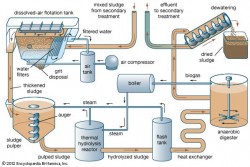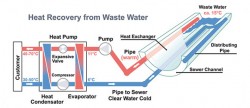 Thermal treatment is a term given to any waste treatment technology that involves high temperatures in the processing of the waste feedstock. This commonly, although not exclusively involves the combustion of waste materials.
Thermal treatment is a term given to any waste treatment technology that involves high temperatures in the processing of the waste feedstock. This commonly, although not exclusively involves the combustion of waste materials.
Systems that are generally considered to be thermal treatment include:
- Gasification
- Incineration
- Pyrolysis
Gasification can be seen as between Pyrolysis and combustion in that it involves the partial oxidation of a substance. This means that oxygen is added but the amounts are not sufficient to allow the fuel to be completely oxidised and full combustion to occur. The temperatures employed are typically above 650°C. The process is largely exothermic but some heat may be required to initialise and sustain the gasification process. The main product is a syngas, which contains carbon monoxide, hydrogen and methane. Typically, the gas generated from gasification will have a net calorific value (NCV) of 4 – 10 MJ/Nm3. The other main product produced by gasification is a solid residue of non-combustible materials (ash) which contains a relatively low level of carbon. For reference, the calorific value of syngas from Pyrolysis and gasification is far lower than natural gas, which has a NCV of around 38 MJ/Nm3.
Incineration: Incineration usually involves the combustion of unprepared (raw or residual) MSW. To allow the combustion to take place a sufficient quantity of oxygen is required to fully oxidise the fuel. Typically, incineration plant combustion (flame) temperatures are in excess of 850ºC and the waste is converted into carbon dioxide and water. Any non-combustible materials (e.g. metals, glass) remain as a solid, known as Bottom Ash, that contains a small amount of residual carbon.
Pyrolysis: In contrast to combustion, pyrolysis is the thermal degradation of a substance in the absence of oxygen. This process requires an external heat source to maintain the temperature required. Typically, relatively low temperatures of between 300ºC to 850ºC are used during pyrolysis of materials such as MSW. The products produced from pyrolysing materials are a solid residue and a synthetic gas (syngas). The solid residue (sometimes described as a char) is a combination of non-combustible materials and carbon. The syngas is a mixture of gases (combustible constituents include carbon monoxide, hydrogen, methane and a broad range of other VOCs). A proportion of these can be condensed to produce oils, waxes and tars. The syngas typically has a net calorific value (NCV) of between 10 and 20 MJ/Nm3. If required, the condensable fraction can be collected by cooling the syngas, potentially for use as a liquid fuel.
Typical Reactors & Applications are given below.
| Reactor | Typical Application | Operating Conditions |
| Rotating Kiln | Pyrolysis | Typically operate at temperatures of between 300 – 850oC. Unit can accommodate large size feed material (200 mm). Kiln is heated externally and waste is fed in from one end of the kiln which slowly rotates creating a tumbling action. This mixes the waste and ensures contact with the heating surface and gases inside the kiln. |
| Heated Tube | Pyrolysis | The tubes are heated externally and temperatures as high as 800 C are used. The process can accommodate large size feed material. The waste passes through the tube at a set speed to ensure the pyrolysis process is complete. |
| Surface Contact | Pyrolysis | Small size feed material required and therefore significant pre-treatment is necessary. Process operates at high temperatures and the small size of the feed gives high heating rates. The application of this technology is to maximise the rate of pyrolysis. |
| Fluidised Bed | Gasification | Fluidised bed technology may be used for gasification or combustion processes. The bed is a mass of particles (typically alumina) that has similar characteristics to a moving fluid. This is achieved by blowing hot gases through the bed of particles. This system provides good mixing and heat transfer to the incoming waste. Waste is pre-treated to remove large sized material. This technology is well suited to the gasification of refuse derived fuels. |
| Fixed Bed | Gasification | There are a range of different reactor types that come under this heading. A typical example is a grate system where the feed passes along the grate and hot gases pass through the bed of waste heating it. |

